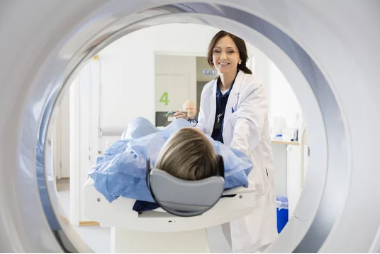Magnetic fields are among the most powerful forces shaping modern science and technology. They guide satellites, run electric motors, and even allow doctors to peer inside the human body. At the same time, they are humanity’s best hope for controlling the immense energy of nuclear fusion, the process that powers the stars.
On one side, Magnetic Resonance Imaging (MRI) uses magnetic fields to create detailed pictures of organs and tissues. On the other, fusion reactors rely on magnetic fields to trap plasma at temperatures hotter than the sun. Though these applications seem far apart, they are united by a single truth: precise control of magnetic fields changes everything.
This article explores how MRI and fusion converge on the science of magnetism—and why this shared foundation could transform both medicine and energy.
The Role of Magnetic Fields in MRI
How MRI Works
MRI scanners harness superconducting magnets to generate fields thousands of times stronger than Earth’s. These magnets align hydrogen protons inside the body. When radio waves disturb this alignment, the protons emit signals that computers translate into detailed images of bones, tissues, and organs.
Key features of MRI magnetic fields:
- Field strength: Clinical MRIs typically run at 1.5–3 Tesla, with research models reaching up to 7 Tesla or higher.
- Uniformity: Even tiny irregularities in the field can distort images, so precision is critical.
- Cryogenics: Liquid helium or advanced cooling systems keep magnets at superconducting temperatures.
MRI has revolutionized medicine, but the technologies it uses have implications far beyond imaging.
The Role of Magnetic Fields in Fusion
Containing a Star on Earth
Nuclear fusion aims to replicate the process at the heart of the sun. To succeed, scientists must heat hydrogen isotopes to more than 100 million degrees Celsius, creating a plasma state. At this temperature, no material can contain the plasma.
The solution? Magnetic confinement.
Fusion devices like tokamaks and stellarators use superconducting magnets to form invisible “cages” around plasma, holding it in place and preventing it from touching reactor walls.
The Challenge of Stability
Plasma is turbulent and unpredictable. Slight shifts in magnetic fields can trigger instabilities that collapse fusion reactions. Just as MRI relies on flawless uniformity for clear imaging, fusion relies on flawless stability for sustained plasma confinement.
Shared Innovations: Where MRI and Fusion Meet
Superconducting Magnets
Both MRI machines and fusion reactors are built on the backbone of superconductors. Advances in high-temperature superconductors (HTS) are reshaping both fields:
- In MRI: HTS allows smaller, cheaper, and more energy-efficient scanners.
- In Fusion: HTS makes it possible to generate ultra-strong magnetic fields, enabling more compact and powerful reactors.
Cryogenic Systems
The cryogenic cooling developed to keep MRI magnets stable has been adapted for the massive superconducting coils in fusion projects. Advances in helium recycling and efficient cooling benefit both industries.
Real-Time Imaging and Control
MRI technology perfected non-invasive imaging inside the body. Fusion research is borrowing these principles to develop plasma imaging diagnostics, allowing scientists to “see” inside reactors in real time. This data helps predict turbulence and prevent instabilities, just as MRI images help doctors diagnose disease early.
Computational Modeling
Image reconstruction in MRI relies on advanced algorithms. Today, similar techniques, along with artificial intelligence, are used to model plasma behavior in reactors, helping researchers anticipate problems and design better control systems.
Case Studies: Magnetic Fields in Action
ITER: The World’s Largest Fusion Experiment
The ITER project in France is building the largest tokamak ever. Its superconducting magnets, weighing hundreds of tons, use design principles that evolved from decades of MRI development. Both depend on field stability and cryogenics, showing how medical science informs energy research.
Commonwealth Fusion Systems (CFS) and HTS Magnets
CFS, a U.S.-based startup, is pioneering the use of HTS magnets for compact fusion reactors. These magnets trace their lineage to superconducting research originally advanced by MRI technology.
Bridging Two Disciplines
Engineers and physicists often move between the fields of MRI and fusion. Expertise in superconductors, magnet design, and cryogenics is transferable, proving that the convergence of these industries is not just theoretical but practical.
Why This Convergence Matters
Healthcare and Energy Synergy
The same magnetic science that lets doctors diagnose illness may one day provide the world with clean, inexhaustible power. This dual benefit highlights the importance of investing in cross-disciplinary research.
Toward a Sustainable Future
If fusion succeeds, it will deliver virtually limitless, carbon-free energy. At the same time, superconducting innovations from fusion research will circle back into medicine, making MRI more accessible and affordable worldwide.
Conclusion: The Shared Power of Magnetism
From saving lives in hospitals to powering cities with clean energy, magnetic fields are at the center of two of humanity’s greatest achievements. MRI and fusion might seem like unrelated technologies, but both rely on the same mastery of superconductors, cryogenics, and precision magnet control.
The convergence of these fields proves a powerful point: the science of magnetism does not belong to one discipline—it belongs to all of humanity.
As MRI continues to refine our understanding of the human body and fusion pushes us closer to harnessing star power, magnetic fields stand as a unifying force, connecting medicine and energy in a shared future of discovery and progress.
Also Read :
